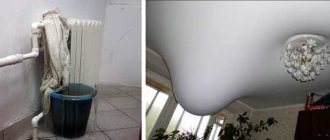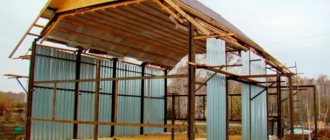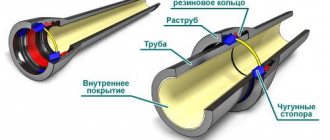Types of gas pipelines
Gas pipelines are divided into:
- Trunk gas pipelines are designed to transport gas over long distances. At certain intervals, gas compressor stations are installed on the pipeline to maintain pressure in the pipeline. At the final point of the main gas pipeline there are gas distribution stations where the pressure is reduced to the level necessary to supply consumers.
- Gas distribution network pipelines are designed to deliver gas from gas distribution stations to the end consumer.
According to pressure in the line:
- Main: first class - at operating pressure over 2.5 to 10.0 MPa inclusive;
- second class - at operating pressure over 1.2 to 2.5 MPa inclusive
- low pressure - up to 0.005 MPa;
By gasket type:
- aboveground;
- underground;
- underwater.
Reserve gas pipelines are constructed for strategic reasons, to provide flexibility in loading gas carriers and to reduce the length of the transportation route.
Which gas stoves should I use for bottled gas?
The reducer installed on the cylinder supplies gas at a pressure of approximately 3.6 kPa, and the gas supplied to the apartments comes at a pressure of about 1.5 kPa. If the flame coming out of the burners has a red tint (normally the flame is blue), and soot appears at the bottom of the pans, then the gas is supplied under high pressure. You can get rid of this problem like this: purchase a plate that matches the pressure, or install a cylinder reducer that reduces the pressure.
Gas stoves designed for bottled gas differ from conventional stoves in two characteristics:
- have a larger diameter nozzle through which the gas passes;
- have a larger cross-section of the fitting for the gas supply hose.
When choosing a stove that can operate on liquefied gas, you need to carefully study the available documents and find a special mark in them. But many stove manufacturers supply their products with replaceable sets of fittings and nozzles that allow the use of any gas.
The stoves that run on liquefied gas include stoves called country or tourist stoves.
If you decide to go with the second option, then you need to purchase an adjustable reducer from a company that refills and repairs cylinders. Such a reducer will be able to produce gas with a pressure of 1.5 kPa. And those reducers that are commercially available reduce the pressure to 3 kPa and, therefore, they will not give the required effect.
Gas supply to residential buildings
The use of gas for heating residential buildings and heating water in the warm season has become possible due to the relatively low cost of this fossil.
After undergoing primary processing, it is cleared of mechanical impurities and chemical additives. Thanks to a wide network of gas pipelines, it can be obtained in any locality and delivered to every home.
Scope of application of natural gas in residential buildings:
- Cooking food
- Heating water in the absence of central hot water supply
- Heating in the cold season
Cooking food. Most homes have gas stoves for cooking. They gained popularity not so much from the price of the stoves, but from the cost of fuel, ease of connection, and uninterrupted supply.
The advantages of gas stoves include ease of operation and low cost of maintenance and repair.
Heating water. The use of natural fuel to heat water in homes became popular in the middle of the last century.
A huge advantage of these systems was the presence of an already supplied source of natural gas to apartments and houses.
A serviceable and adjusted column provided stable hot water for the needs of each consumer in the absence of a central hot water supply.
Heating. This type of gas use has found wide application in private homes where central heating is not practical.
Each consumer, having an existing gas supply system in their arsenal, installed a heating boiler for their needs.
Depending on the area of the house, a boiler was purchased and a heat distribution system was installed throughout the house.
The consumer himself chose the temperature in his home depending on weather conditions and, accordingly, gas consumption.
Conclusions on the topic
| Fuel type | Efficiency | Connection cost | Fuel cost | Connection speed | Safety |
| Natural gas (mainline) | 97% | 350-500 thousand rubles | 2000 rubles per month | From a month to six months | High, with proper operation and timely maintenance |
| LPG (gas holder) | 97% | from 350 thousand to several million rubles | 5000 rubles per month | 1-3 days | High, with proper operation and timely maintenance |
So, if there is a gas pipe near your house and you are ready to wait, connect to it.
Connection prices will be comparable to a gas tank, but you will be able to save on fuel costs in the long run. If the highway is located far away and your site meets the basic requirements, then we advise you to dig a pit for the tank. This way you can ensure autonomous gasification of the entire site in a short time.
Which option did you choose? How long did it take to coordinate the connection to the main gas pipeline? Which gas holder did you choose and how quickly was it installed? Remember, our experts will answer all your questions.
What does natural gas consist of - gas composition
98% of natural gas consists of methane, and this amount varies slightly depending on where it is produced.
It also includes:
- Butane
- Propane
- Ethane
- Pentane
- Hexane
- The composition contains hydrogen sulfide, carbon dioxide, and water vapor.
To use gas in everyday life, it must have certain parameters, which are regulated by GOST 5542-2014 “Natural flammable gases for industrial and municipal purposes. Technical specifications In order to obtain the established parameters, the supplier purifies the product, removes excess impurities from the composition, and only after that can supply it to the market.
What gas is used in residential buildings
Natural gas entering residential buildings is a flammable mixture of various gaseous substances and impurities. Depending on the mining region, it differs in its quantitative and qualitative composition. But regardless of this, it performs its main function - releasing a large amount of heat during combustion.
An alternative to a centralized gas supply system is the use of gas cylinders or special containers (gas holders). This system is used in private homes. Supplying gas to such houses is often unprofitable and impractical. Gas equipment in summer cottages can be used inconsistently and it is more profitable for their owners to purchase liquefied gas in cylinders or install gas tanks.
What types of gas tanks are there?
Gas holders are special containers designed for storing liquefied gas. Variable-volume tanks are widely used in industry, but in everyday life only gas tanks of constant volume should be used. This is due to security requirements. The operating gas pressure in the gas tank should be 16 atmospheres.
A gas holder is a device for storing liquefied gas; its specific characteristics for each home are determined in accordance with the technical conditions of the facility (+)
Such a tank looks like a cylinder, although sometimes spherical models are also found. The volume can vary within a very wide range - up to fifty thousand cubic meters, although such large volumes are not needed for a private home. There are gas holders for installation underground, but there are also above-ground models.
The choice largely depends on the nature of the gas used. For a summer cottage that is not used in winter, a ground-based gas holder is suitable. You can use a mobile gas tank.
But if people live in a house or cottage all year round, you should definitely install an underground tank.
Gas tanks designed for installation underground are more in demand than above-ground models, since they provide a stable temperature for storing liquefied gas
Although it is easier to install an above-ground gas tank, there are more problems with its operation. Due to the influence of high and unstable temperatures, such devices are subject to more stringent safety requirements. The cost of above-ground installations is also usually higher than for underground counterparts.
As a rule, land-based models are installed where large gas consumption is not planned. The container will be emptied periodically, so you need to immediately think about whether to prefer a stationary or mobile option. Refueling of mobile models equipped with wheels for towing is carried out as follows:
If there is a need to use a ground model in winter, i.e. At lower temperatures, you will need to use an evaporator. This is an electrical device that provides safe heating of a gas container.
As a result, LPG quickly turns into a gaseous state and enters the system, providing sufficient pressure.
Underground gas tanks can reach volumes of 50 cubic meters, but for a private home you usually need a smaller container
Gas tanks designed for installation underground are considered more reliable and safe. However, their installation will require more time, cost and effort.
This is due to large-scale work. Installation above soil freezing is not allowed, and in many regions this figure is 1.5 m or even more.
The contents of the reservoir, located inside the soil, are almost completely at a temperature of 5-8°C. A special evaporator is not needed for this model.
For a specific site and project, a gas tank is selected in accordance with the technical conditions developed for an autonomous gas supply system. Typically, the organization tasked with completing the project will purchase the device itself, taking advantage of discounts that manufacturers provide to such customers.
The gas tank control system is installed on its top cover. The pressure gauge allows you to control the pressure inside the container, which should not exceed critical limits (+)
Independent searches and purchase of a gas holder usually do not give the owner of the site the opportunity to save, but increase the risk of purchasing a low-quality or unsuitable device.
On our website there is a series of articles devoted to the selection and installation of gas tanks.
We advise you to read:
- Types of gas tanks: classification basics + review of popular brands
- Turnkey gas tank: how to install a gas tank and install equipment
- The cost of installing a gas tank in a private house: prices for gasification work
In addition to gas holders, liquefied gas cylinders can also be used for autonomous gas supply. One such capacity is usually not enough; several are combined into a common network.
How does natural gas differ from liquefied gas?
Depending on the type of gas used in everyday life, it can be delivered to the consumer in two ways:
- Through a pipeline system directly connected to a gas stove or water heater. With this option, it comes immediately in a gaseous state and is suitable for use.
- Through the ground transport system. Some household and industrial gases are pre-placed in cylinders or special containers (gas holders). There they are in a liquefied state. Depending on the type of gas, the process of turning into a liquid may differ. To convert household gas back into a gaseous state, simply open the cylinder.
Natural gas is suitable for use almost immediately after its extraction. The absence of the need for additional transportation costs makes this type of fuel the cheapest and most convenient for use in everyday life. Depending on what gas is used: propane or butane, the methods of bringing it to a liquid state and placing it in a cylinder differ. There are also differences in the methods of transporting cylinders and safety precautions during their operation.
Depending on what kind of gas is used in residential buildings, it is necessary to ensure its delivery to the consumer, to correctly select, connect, configure and maintain equipment, as well as to take measures for the safe use of this gas.
Rules and regulations
To determine the required distance from the gas pipe, after developing a residential building project, citizens of the Russian Federation apply for the appropriate permit (approval) from the local gas distribution organization. For a definite answer, you need to know the type of gas pipeline and what pressure is used when supplying it. If there is no data on the type of laying and the pressure in the pipes, it is impossible to give an unambiguous answer.
Gas distribution station
SNiP 42-01-2002 is one of the natural results of the Federal Law of the Russian Federation “On Technical Regulation” No. 184, adopted in December 2002. In November 2008, the Government of the Russian Federation adopted Resolution No. 858, according to which the current sets of rules were developed and approved. This SP was approved at the legislative level in an updated version and was named SP 62.13330.2011.
The most affordable type of fuel has become widespread and has become a publicly available energy resource. Its widespread use has led to the urgent need to develop regulatory documents in which the permitted distances can be found.
Compressor station
Since 2010, SNiP registered by Rosstandart:
- are legislative documents, compliance with which is mandatory;
- checked by supervisory organizations designed to ensure the safety of such structures;
- may be the basis for a decision in a lawsuit;
- are recognized as a significant reason for imposing an administrative penalty upon violation.
SP 62.13330.2011 regulates the distances that must be observed depending on the type of laying of the main gas pipeline or its branches and the pressure of liquid fuel in the pipes.
Near a residential building
If gas is supplied in cylinders, only the prescribed fire safety standards must be observed. More economical and volumetric transportation in pipes provides for differentiated requirements for different types of supplies and pressure levels during their implementation.
Connection diagram
Gas pressure in the gas pipeline of a residential building
In order to ensure a stable and uninterrupted supply of natural gas to apartments, a pressure of up to 12 MPa is created in the pipelines of transport highways. Then the gas supplied to gas distribution stations is distributed to residential buildings. In gas pipelines of utility networks of apartment buildings, gas movement is ensured by pressure reduced by 10 times. To ensure its suitability for domestic use, additional processing and purification of natural gas is carried out at gas distribution stations.
Calculation of maximum hourly gas consumption
Owners of private farmsteads may well be guided by a gas consumption rate of 5 m³/h (the first category of gasified farms) - this volume is most often sufficient for domestic use.
However, it is possible to independently calculate the approximate gas consumption of heating equipment using the formula:
B=q·10³/nп·1.163·8000,
Where:
- B – natural gas consumption by household equipment, m³/h;
- q – heat performance of gas-consuming equipment, kW;
- n/a – efficiency of gas-consuming equipment (usually 90-92%);
- 1,163 – the value of the conversion factor from kW to kcal;
- 8000 – calorific value of natural gas (lower), kcal/Nm³.
Using this formula, we calculate the peak consumption of heating equipment. For example, the heated area of a cottage is 120 m² and it is planned to use a 12 kW boiler with an efficiency of 90% to heat it.
We consider: B=12·1000/0.9·1.163·8000=12000:8373.6=1.5 m³/h (rounded)
The thermal power of other household appliances must be found out from the technical data sheets. A gas four-burner stove with oven, for example, usually has 10 kW of power. Then its peak gas consumption will be (efficiency is not taken into account):
B=10·1000/1.163·8000= 10000:9304=1.1 m³/h (rounded). By calculating the maximum consumption of natural gas per hour for each consumer in the house and summing it up, we obtain the value of the required gas consumption per hour (MRG) for the entire household.
Dangerous properties of natural gas
Each of us, from school age, begins to be told about the need to carefully handle fire and household gas. However, not everyone knows what the consequences of leakage of this substance are.
For example, there is a widespread misconception that a person can be poisoned by household gas. This is impossible, because The natural gas supplied to homes is itself non-toxic. Death from leakage occurs due to asphyxiation. When gas molecules used in everyday life enter the lungs, they block access to oxygen. And the person dies, no longer able to breathe.
Natural gas is explosive. Once you smell it (more precisely, the smell of odorant), you need to stop using all electrical appliances, including those operating offline, and also not use open fire. Be sure to open all doors and windows, then call the gas service. These are measures to prevent an explosion from occurring when a dangerous gas concentration in a room is reached (5 - 15% of the total air mass). It is impossible to determine the level of gas pollution on your own, so it is better to play it safe and follow the recommendations. And also remember that the highest concentration of the substance in the room will be at the top, because Natural gas is almost 2 times lighter than air.
You can prevent dangerous consequences from gas used in everyday life by installing a special gas analyzer that will warn of a leak. And, of course, have a working ventilation system that will not allow high gas concentrations in the room.
Risk of explosion and fire from gas
In case of poor ventilation, an explosive mixture may accumulate in the room, and with a small spark or the use of open fire, an explosion may occur, which will cause a fire.
Regular inspection and cleaning of ventilation ducts can eliminate the risk of fire from gas leaks.
Modern methods of monitoring gas leaks in everyday life are individual gas analyzers, which can be installed near gas appliances on the ceiling. When there is a gas leak, they give a signal to which the owner must respond.
Gas cylinders used in everyday life
In addition to natural gas supplied through the central gas pipeline, liquefied gas is often used. Basically, it is propane-butane, which is obtained from oil refining. Other hydrocarbon mixtures are less common.
Liquefied natural gas is practically not used in everyday life. It is also rarely used in industrial plants due to the difficulty of keeping the substance in a liquid state. This requires greater pressure and thickness of the tank, which is significantly more expensive.
Liquefied propane-butane gas used in residential buildings has a high calorific value, which is a definite advantage. For example, the room will be heated longer when using a cylinder. At the same time, propane-butane gas is much more explosive than natural gas.
When deciding to switch to using liquefied gas cylinders, you should take into account that when connecting to the stove, the nozzles will need to be reconfigured or changed. The diameter of the hole in the nozzle regulates the amount and speed of the supplied gas. These values differ depending on the particular substance used due to differences in composition, and, consequently, properties and characteristics.
An unsuitable nozzle will lead to unnecessary gas leakage and soot marks on the dishes or a low-temperature flame. Both of these options mean increased utility costs due to increased fuel consumption.
Classification of gas pipelines by installation method
Here you can see 2 types - underground and aboveground gas pipelines.
Underground gas pipelines are external; they are laid below ground level or along its surface in an embankment. The pressure in such a gas pipeline can be any. The construction of such gas pipelines is regulated by the provisions of SNiP; distances from other underground communications must be strictly observed. Pipe material: steel or polyethylene. Steel pipes must be coated with a layer of insulation to protect against corrosion. Repair and maintenance of underground gas pipelines are carried out by operational services.
Laying an underground gas pipeline
Advantages and disadvantages
An underground gas pipeline is constructed underground. Its installation is more expensive due to the complexity of the work. It is also necessary to carry out engineering-geological and geodetic surveys. The steel pipe must have electrochemical protection against stray currents. A polyethylene pipe does not need this. But the big plus of underground installation is that the pipe underground is better protected from external influences, thereby increasing its durability. Also, an underground gas pipeline is much safer than an above-ground one.
Such gas pipelines are installed only from metal pipes that comply with GOST standards
LNG transportation
What to do with hard-to-reach areas located far from the main gas pipelines? To such areas, gas is transported in a liquefied state (liquefied natural gas, LNG) in special cryogenic tanks by sea and by land.
By sea, liquefied gas is transported on gas carriers (LNG tankers), ships equipped with isothermal tanks.
LNG is also transported by land, both rail and road. For this purpose, special tanks with double walls are used that can maintain the required temperature for a certain time.
Ecology
Natural gas is the cleanest among hydrocarbon fossil fuels. Ideally, its combustion produces only water and carbon dioxide, while the combustion of petroleum products is accompanied by the formation of soot and ash.
Of course, emitting large amounts of carbon dioxide into the atmosphere in itself is not safe. According to some scientists, they can lead to the greenhouse effect, and as a result, to significant climate warming. However, it is worth noting that natural gas also wins in this regard - CO2 emissions during its combustion are significantly lower than those of petroleum fuel.
Reasons for moving gas pipes in the kitchen
All work on moving and replacing metal pipes, especially those requiring welding, is carried out by representatives of Gorgaz or another authorized organization. Having received an application from residents, they are always interested in the reasons for the planned transformations.
Most often, it is necessary to change the piping in the kitchen without changing the layout or moving equipment to other rooms. The reasons may be different:
- replacing old equipment - purchasing a gas water heater, stove or boiler - which requires a little more space;
- major renovation in the kitchen;
- moving the gas stove from the window 0.5-2 m towards the sink;
- changing the installation location of the gas meter;
- moving a horizontal pipe from a great height under a table top, etc.
Often, the relocation of pipes is required in new buildings, where the original location of significant kitchen objects defies logic and explanation: suppose, if in a 15-meter kitchen the gas stove is located near the window, the sink is in the opposite corner, and the hood is on the other side, above the entrance to the kitchen. We have to correct the design mistakes and move the stove closer to the sink so that food can be cooked in comfortable conditions.
It is strictly forbidden to carry out work to move the gas riser. The only change allowed is to disguise the pipes with easily dismantled structures, for example, wall-mounted kitchen cabinets
The most common reason is the purchase of a new kitchen set with built-in equipment (oven and hob). In this case, the pipes need to be either shortened or lengthened, depending on the planned installation location of the devices.
If you want to find out how best to move a gas pipe in an apartment with redevelopment, we recommend contacting a design organization to draw up a transfer plan. The fact is that in typical city apartments it is prohibited to reinstall risers, pipes, as well as any gas equipment in living rooms, and even to combine a kitchen and a room, permission is also required.
Obtaining approval for gas pipeline replacement
Whether a transfer is possible or not can only be decided by authorized bodies, that is, the gas service of your city (district). Only a qualified specialist has the right to carry out any dismantling and installation work. Of course, pipes cannot be moved without approval.
Even such a simple step as cutting a pipe by 10 cm must be approved, since all work related to the gas pipeline falls into the risk category
The permit is issued in the following sequence:
- Find out the contact details of the gas service at the place of registration, contact specialists, explain the situation, and consult.
- You draw up an application (using a standard form) that will “launch” the approval process.
- Based on your application, a gas service representative will arrive at your home. The time will be confirmed in advance.
- The specialist performs an inspection, listens to wishes, and answers questions. Often at this stage it is necessary to change plans, since the desired transfer does not meet safety requirements (a preliminary study of the gas pipeline installation standards will eliminate this unpleasant moment).
- Approval of the final transfer scheme, drawing up an estimate. All documents are prepared by the organization providing the services. No work will be carried out without the consent of the property owner.
- If the transfer conditions are met, pay for the service using a receipt and agree on the start time of the work.
The approval procedure usually takes several days; it can drag on for a long period for only one reason: if the property owners and representatives of the gas service have not found a compromise solution. Any factors that violate the installation standards for gas stoves (boilers, meters, water heaters) may cause refusal to move pipes.
Costs of putting the gas pipeline into operation
The actual construction of gas communications on the site does not mean the end of costs. The gas pipeline still needs to be put into operation, otherwise it cannot be used.
To commission a gas pipeline at the site, you need:
- control shooting (preparation, registration) – 15,000-35,000 rubles . The shorter the gas pipeline, the cheaper the CIS;
- inspection of ventilation ducts and chimneys in the form of a report - approximately 5,000 rubles. ;
- grounding of the boiler (protocol and sketch of the circuit) - about 5,000 rubles. ;
- inspection of insulating connections in the form of a report – 7,000 rubles. for each ;
- verification of executive and technical documentation – 4,000 rubles. ;
- calling Mosoblgaz inspectors - approximately 3,000 rubles. ;
- preparation of a gas inlet service agreement – up to 2,000 rubles ;
- re-approval of the project will cost a maximum of 4,000 rubles .
Upon completion of work on the operational commissioning of the gas pipeline, it is necessary to draw up executive and technical documentation at the local gas service distribution zone, sign it at the gas service trust and submit it to the archives.
Next, make an entry for gas insertion and initial start-up. For the Moscow region, the costs of ITD and launching the gas pipeline will be about 35,000-5,0000 rubles.
How toxic and explosive is natural gas?
The gas used in a residential building is not toxic, so cases of poisoning with it can be excluded. If an emergency occurs, a person may die from suffocation rather than from gas poisoning.
When blue fuel leaks, carbon dioxide molecules enter the human lungs. They displace oxygen molecules, which causes suffocation and can lead to death.
Methane is a flammable and explosive fuel. If its ratio with air is 15 to 85 percent, then there is a danger of explosion. Without special instruments, it is impossible to determine the concentration. If you smell gas, you need to take safety measures:
- open windows and doors in the house;
- turn off electrical appliances and lamps (you cannot use a mobile phone);
- call the appropriate service; gas specialists must be present as part of the emergency team;
- do not use matches or other objects to create fire.
Why does gas smell in apartments?
Specializes in family issues, civil, criminal and housing law. Initially, natural fuel is odorless, so the consumer will not be able to detect its leakage, which may result in an explosion. In order to avoid such situations, special liquids are sprayed into the gas used in apartments. They give the fuel an unpleasant, pungent odor, upon sensing which consumers will be able to determine the leak and call the gas service.
How to protect yourself when using gas appliances
Fuel and equipment must be used according to certain rules:
- Every year, gas service employees must check gas appliances and the in-house gas supply system.
- Periodically monitor the draft level in the kitchen or in another room where gas equipment is installed. If an insufficient level of ventilation is detected, the shaft will need to be cleaned.
- In winter, do not close the ventilation.
- After finishing using the gas, turn off the valves and taps of the pipelines located near the equipment.
- While equipment is operating on methane, it must not be left uncontrolled.
- If you smell gas, you should follow the recommendations presented above.
- A gas analyzer can be mounted on the ceiling above gas appliances. If a fuel leak occurs, residents will be notified by an audible signal.
The above recommendations will help users avoid accidents.
Not allowed:
- move gas equipment on your own initiative and install it yourself;
- allow preschool children to use gas stoves and other equipment without parental control.
What does this or that color of fire in the burner indicate?
The shade of the flame in a gas burner can tell you about the combustion characteristics of natural fuel. If the fire has a rich blue color of a homogeneous structure, it means that the gas is completely burned. At the same time, the maximum possible amount of heat is released into the space.
What happens when the flame in the burner turns reddish or bright yellow? If the combustion gas is any color other than blue, this may indicate that the burner is receiving limited air or the gas is of poor quality. In this case, fossil fuels do not provide heating efficiently enough. To eliminate this drawback, it is enough to call a qualified specialist by contacting the gas industry.
As you can see, the color of a gas when burning can provide useful information. A yellowish or reddish tint of the fuel when ignited indicates that low-density gas is being supplied to the house. And since heating boilers are designed to consume fuel of a certain quality, when the gas density decreases, the equipment will need more substance to create a comfortable temperature.
In fact, yellow or red flames on the igniter indicate that the devices are using more fuel. Management companies may be to blame for such an omission. Some of them deliberately reduce the carbon dioxide and hydrocarbon content in the gas. Therefore, if the color of the flame on a gas burner changes, users have the right to contact the supplier for clarification.
Why does gas explode so violently in residential high-rise buildings?
To turn on the column in water heating mode, the following conditions must be met: the presence of water in the water supply system and sufficient pressure, the presence of draft in the chimney to prevent carbon monoxide poisoning during its operation, sufficient pressure in the gas supply system. The chimney is used to remove gas combustion products outside the room. The burned gas releases heat, which is transferred to the cold water flowing through it. The output is water heated to the required temperature for domestic needs. The ignition unit allows you to ignite the gas when a command is given from the automation unit. Basic rules of gas safety in everyday life In order for the use of gas appliances in everyday life to bring only benefits, it is necessary to comply with the requirements of the rules for the safe operation of gas appliances: Inspect the equipment annually by qualified specialists Constantly check the draft in the room where gas appliances are located Do not block the ventilation grilles in winter Do not leave running appliances unattended. After finishing use, close the taps on the appliances and valves in front of them. If you smell gas in the room, do not turn on the lights, do not use open fire. Open the doors, windows and ventilate the room, then call the emergency gas service to inspect and eliminate the leak.
Recommendations for safe use of gas
In practice, most explosions and fires are caused by human factor, neglect of safety precautions when using gas, and negligence in handling gas equipment.
To protect yourself and your loved ones, you need to follow a number of norms and generally established rules. This will help prevent explosive situations and all adverse consequences associated with gas leaks.
Rules for operating gas equipment
Any gas equipment should be purchased only from specialized companies that can present certificates for the sale of this type of product. Please note that the kit contains instructions for the safe use of the device.
Installation and repair work must be carried out by specialists from relevant organizations. Unauthorized gasification of a house or apartment, replacement, reinstallation and changes to the design of gas appliances are strictly prohibited
It is important to adhere to the following rules for operating gas equipment:
- carefully read the instructions and follow the recommendations indicated therein;
- do not use the equipment for other purposes (heat the apartment using a gas stove);
- monitor the performance of devices and ventilation, annually invite specialists to check the draft;
- ensure normal air flow in the room, do not isolate ventilation openings, do not block gas pipes;
- do not leave functioning devices unattended, especially in rooms with young children, and also if the devices are not designed for continuous operation and are not equipped with appropriate automation;
- do not tie clotheslines to gas pipelines;
- turn off gas valves and taps on the pipeline before leaving home; if you are away for a long time, it is better to turn off the electricity;
- Do not blow out or pour water or other liquids onto the flame on the burner.
It is very important to regularly check the condition and tightness of hoses, fittings, and threaded connections. The optimal length of the flexible hose is no more than 2 meters, the maximum service life is up to 4 years.
The hose should be tightly placed on the gas valve, but it is not recommended to overtighten the clamp clamp.
We discussed more recommendations for the safe operation of gas equipment in this article.
Most often, gas leaks occur due to ruptures in the hoses connecting the stove to the gas pipeline or failure of sealing in the area of threaded seams. Another common reason is the inattention of users who forget to close the valves responsible for the gas supply.
If you feel the characteristic smell of gas in the apartment, you must immediately turn off the burner taps and valves on the pipeline. You should also open doors and windows and thoroughly ventilate the gas-filled room, making sure that everyone present quickly leaves it.
People affected by gas should be immediately taken out into fresh air and given first aid:
- lay on your back so that your legs are higher than your body;
- remove tight clothing;
- cover, rub the chest, bring ammonia;
- when vomiting, turn on side;
- If possible, drink plenty of water.
You cannot do anything that could create a spark or flame: smoke, light a fire, turn on/off electrical appliances, lighting, press the bell button, use mobile devices.
It is advisable to immediately report the incident to the emergency gas service. While the rescuers arrive, it is worth warning your neighbors about the situation.
Leak detection methods
Several proven methods are used to detect gas leaks indoors. The simplest and most common option is to inspect the surface by applying soapy water along the gas pipes. , bubbles form in problem areas .
The most reliable way to avoid trouble is to install a carbon monoxide detector.
This modern, ultra-sensitive device - a gas leak sensor - will instantly notify you of the slightest problem through a sound or light alarm.
You can also detect a leak by hearing or smelling it. If there is a strong leak, the fuel mixture escapes from the pipes with a whistle. It is easy to smell the specific smell of odorants added to the fuel structure during processing.











